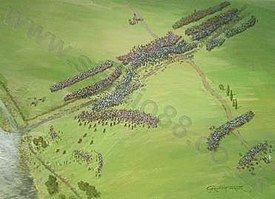(4000-7000 total casualties)≈800 men killed≈700 men wounded+4,000 men captured along with the entirety of the Veronese artillery and both Ordelaffi and da Polenta Light | Date 11 March 1387 | |
 | ||
≈ 11,000-16,000 men with ( 12,000-16000 reserves, mostly peasants) Total ≈ 7,000-9,200 menSoldiers brought by John Hawkwood≈ 600 cavalry≈ 500 archersThe army of Padua and their other condottieri≈8,000 men Similar War of the Eight Saints, Battle of Parabiago, Battle of Maclodio, Battle of Cascina, Battle of Mbororé | ||
Battle of castagnaro
The Battle of Castagnaro was fought on March 11, 1387 at Castagnaro (today's Veneto, northern Italy) between Verona and Padua. It is one of the most famous battles of the Italian condottieri age.
The army of Verona was led by Giovanni Ordelaffi and Ostasio II da Polenta, while the victorious Paduans were commanded by John Hawkwood (Giovanni Acuto) and Francesco Novello da Carrara, the son of Francesco I, lord of Padua. John Hawkwood brought 1,100 of his own condottiere (600 cavalry and 500 archers, or vice versa depending on the source) to supplement the Paduan forces of 8,000 men (Giuseppe Marcotti places the number dismounted condottiere at 6,000 men, along with a reserve of 1,600 horse. He also goes on to say that there were 1,000 native footmen of Padua, and 600 crossbowman guarding a river bank.)
Castagnaro is hailed as Sir John Hawkwood's greatest victory. Following a Fabian-like strategy, Hawkwood goaded the Veronese into attacking him on a field of his own choosing, by laying waste to the Veronese lands nearby.
Drawing his forces up on the far side of a canal, and anchoring his right flank on a patch of woods, Hawkwood waited until the Veronese had committed to attacking across a ford of fascines piled up in the canal. Once so occupied, Hawkwood sprang his trap.
Hawkwood had left a copy of his standard behind his forces, then had led his cavalry into the woods to his right. At a given signal — supposedly, a flaming arrow — the copy of his standard dropped, and Hawkwood's cavalry burst from the woods on the Veronese left, with his real standard in front. At the point of impact, Hawkwood is said to have cast his commander's baton into the Veronese ranks and ordered his men to retrieve it for him.
Per Trease, it is said that Hawkwood's battle cry that day was a grim play on the Paduan war-cry of Carro! ("Cart!", from the coat of arms of the House of Da Carrara) — in Hawkwood's rendition, it became Carne! ("Flesh!").
Curiously though, the Florentine reserves under Ischia stood their ground against Hawkwood's terrible onslaught. They could do nothing to turn the tide of battle since the Hawkwood's men were all heavily armed, whilst the peasants were not.
